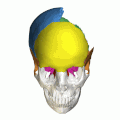| Neurocranium | |
|---|---|
 The eight bones that form the human neurocranium. | |
 The eight cranial bones. (Facial bones are shown in transparent.) | |
| Details | |
| Identifiers | |
| Latin | neurocranium |
| TA98 | A02.1.00.007 |
| TA2 | 354 |
| FMA | 53672 |
| Anatomical terms of bone | |
In human anatomy, the neurocranium, also known as the braincase, brainpan, brain-pan, [1] [2] or brainbox, is the upper and back part of the skull, which forms a protective case around the brain. [3] In the human skull, the neurocranium includes the calvaria or skullcap. The remainder of the skull is the facial skeleton.
Contents
- Structure
- Development
- Other animals
- Additional images
- See also
- References
- External links
- External links 2
In comparative anatomy, neurocranium is sometimes used synonymously with endocranium or chondrocranium. [4]




